Research Report: Big Data Utilization in Telecom Business
VerifiedAdded on 2021/06/17
|13
|2854
|124
Report
AI Summary
This report examines the utilization of big data within the telecommunications industry, highlighting its significance in strategic decision-making, customer relationship management, and overall business value creation. It explores how telecom companies leverage big data analytics to understand customer needs, improve service offerings, and enhance marketing strategies. The research delves into the challenges faced by telecom companies in managing and extracting value from vast datasets, while also considering the limitations and ethical implications of big data applications. Through a combination of qualitative and quantitative research methods, including literature reviews, surveys, and statistical analysis, the report aims to provide a comprehensive understanding of the transformative role of big data in the telecom sector and its potential for future growth and innovation. Desklib provides access to this document along with a wide range of study resources.
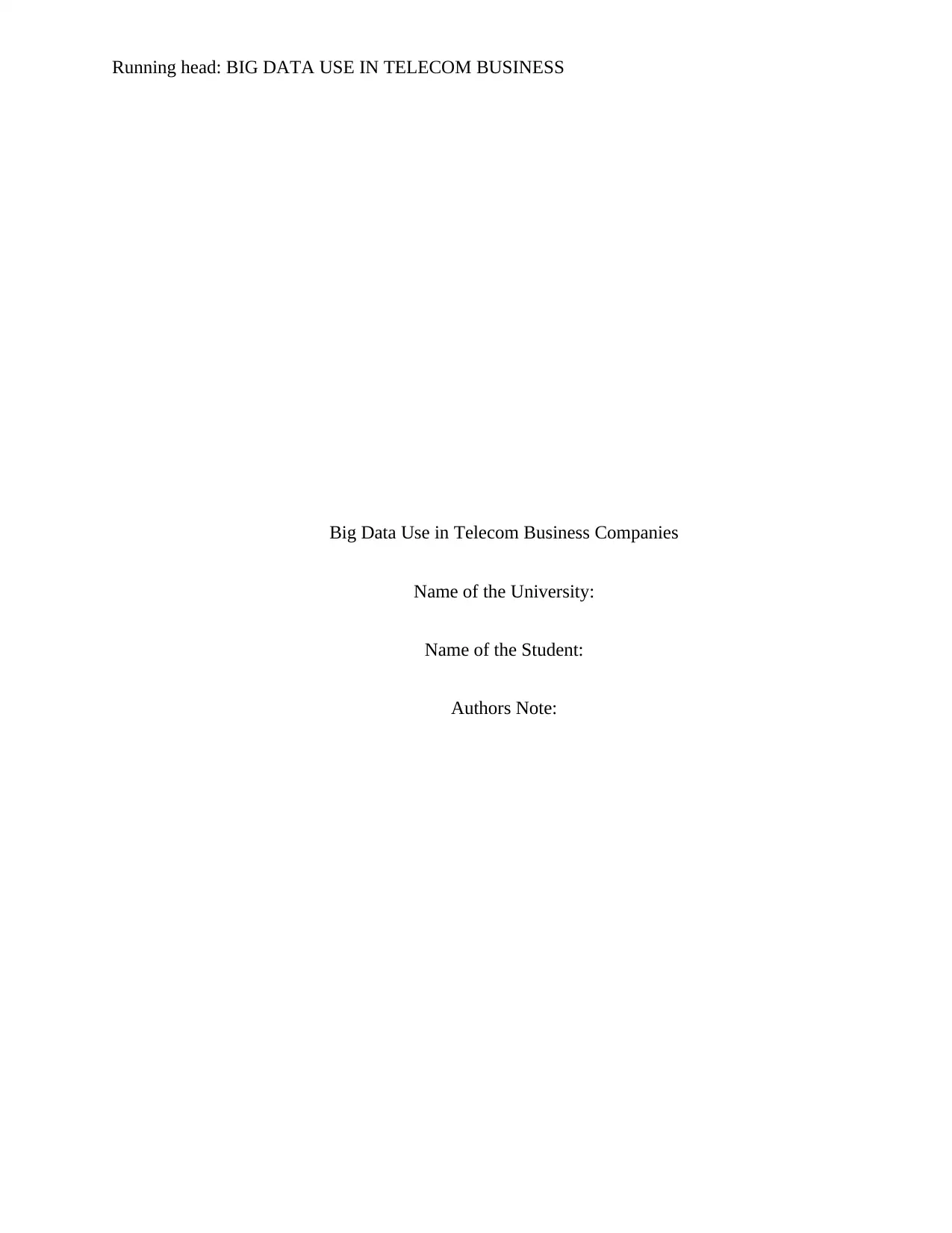
Running head: BIG DATA USE IN TELECOM BUSINESS
Big Data Use in Telecom Business Companies
Name of the University:
Name of the Student:
Authors Note:
Big Data Use in Telecom Business Companies
Name of the University:
Name of the Student:
Authors Note:
Paraphrase This Document
Need a fresh take? Get an instant paraphrase of this document with our AI Paraphraser
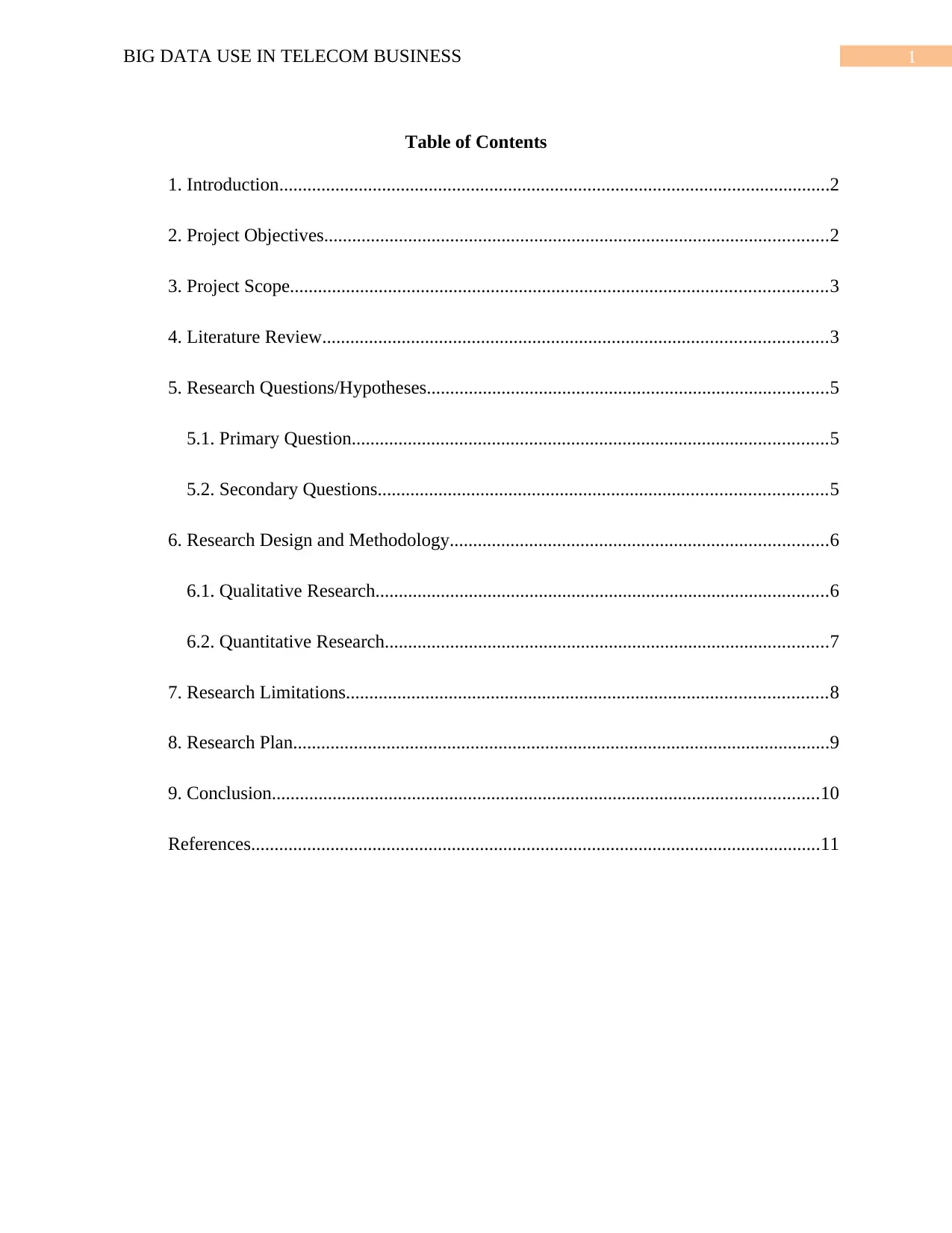
1BIG DATA USE IN TELECOM BUSINESS
Table of Contents
1. Introduction......................................................................................................................2
2. Project Objectives............................................................................................................2
3. Project Scope...................................................................................................................3
4. Literature Review............................................................................................................3
5. Research Questions/Hypotheses......................................................................................5
5.1. Primary Question......................................................................................................5
5.2. Secondary Questions................................................................................................5
6. Research Design and Methodology.................................................................................6
6.1. Qualitative Research.................................................................................................6
6.2. Quantitative Research...............................................................................................7
7. Research Limitations.......................................................................................................8
8. Research Plan...................................................................................................................9
9. Conclusion.....................................................................................................................10
References..........................................................................................................................11
Table of Contents
1. Introduction......................................................................................................................2
2. Project Objectives............................................................................................................2
3. Project Scope...................................................................................................................3
4. Literature Review............................................................................................................3
5. Research Questions/Hypotheses......................................................................................5
5.1. Primary Question......................................................................................................5
5.2. Secondary Questions................................................................................................5
6. Research Design and Methodology.................................................................................6
6.1. Qualitative Research.................................................................................................6
6.2. Quantitative Research...............................................................................................7
7. Research Limitations.......................................................................................................8
8. Research Plan...................................................................................................................9
9. Conclusion.....................................................................................................................10
References..........................................................................................................................11
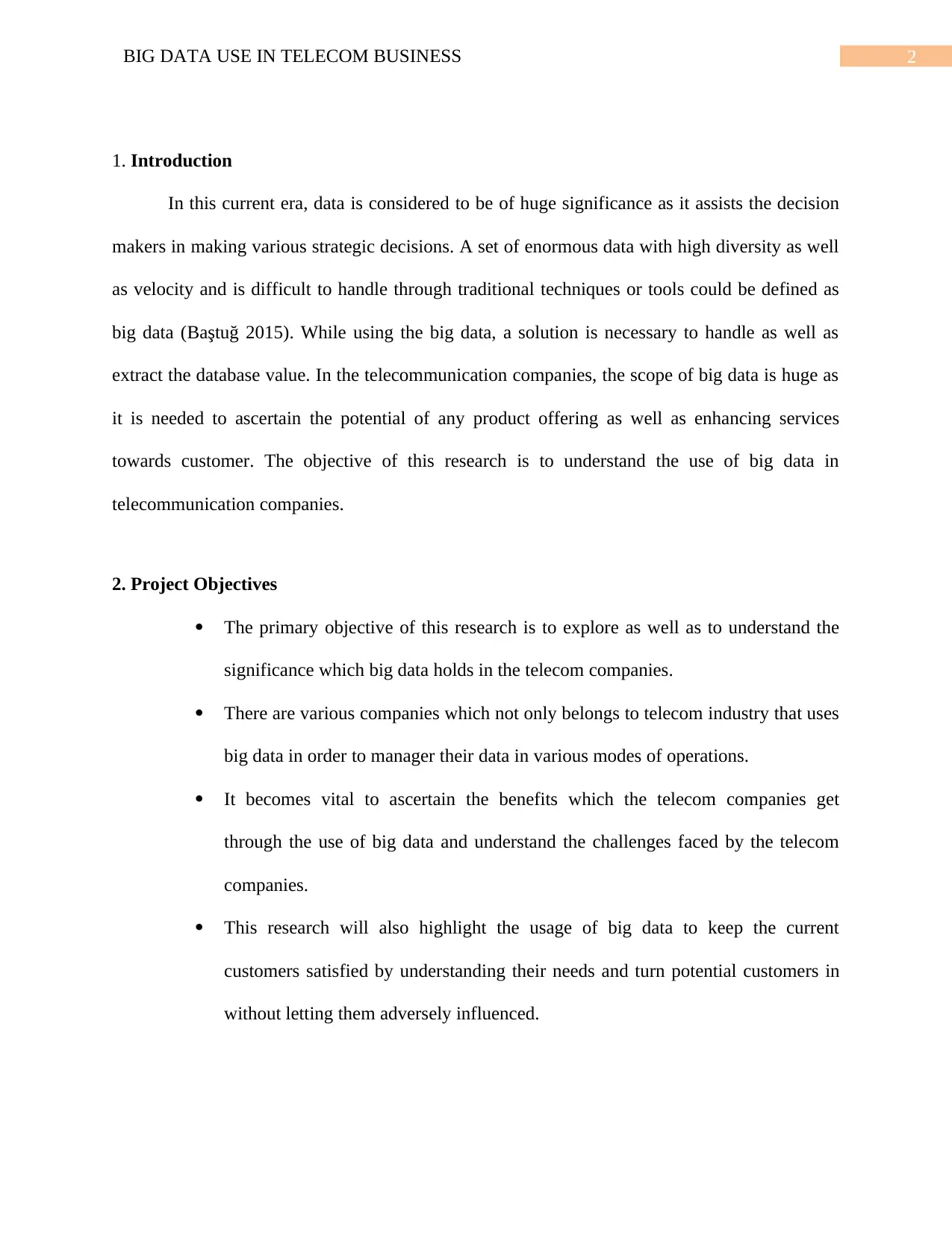
2BIG DATA USE IN TELECOM BUSINESS
1. Introduction
In this current era, data is considered to be of huge significance as it assists the decision
makers in making various strategic decisions. A set of enormous data with high diversity as well
as velocity and is difficult to handle through traditional techniques or tools could be defined as
big data (Baştuğ 2015). While using the big data, a solution is necessary to handle as well as
extract the database value. In the telecommunication companies, the scope of big data is huge as
it is needed to ascertain the potential of any product offering as well as enhancing services
towards customer. The objective of this research is to understand the use of big data in
telecommunication companies.
2. Project Objectives
The primary objective of this research is to explore as well as to understand the
significance which big data holds in the telecom companies.
There are various companies which not only belongs to telecom industry that uses
big data in order to manager their data in various modes of operations.
It becomes vital to ascertain the benefits which the telecom companies get
through the use of big data and understand the challenges faced by the telecom
companies.
This research will also highlight the usage of big data to keep the current
customers satisfied by understanding their needs and turn potential customers in
without letting them adversely influenced.
1. Introduction
In this current era, data is considered to be of huge significance as it assists the decision
makers in making various strategic decisions. A set of enormous data with high diversity as well
as velocity and is difficult to handle through traditional techniques or tools could be defined as
big data (Baştuğ 2015). While using the big data, a solution is necessary to handle as well as
extract the database value. In the telecommunication companies, the scope of big data is huge as
it is needed to ascertain the potential of any product offering as well as enhancing services
towards customer. The objective of this research is to understand the use of big data in
telecommunication companies.
2. Project Objectives
The primary objective of this research is to explore as well as to understand the
significance which big data holds in the telecom companies.
There are various companies which not only belongs to telecom industry that uses
big data in order to manager their data in various modes of operations.
It becomes vital to ascertain the benefits which the telecom companies get
through the use of big data and understand the challenges faced by the telecom
companies.
This research will also highlight the usage of big data to keep the current
customers satisfied by understanding their needs and turn potential customers in
without letting them adversely influenced.
⊘ This is a preview!⊘
Do you want full access?
Subscribe today to unlock all pages.

Trusted by 1+ million students worldwide
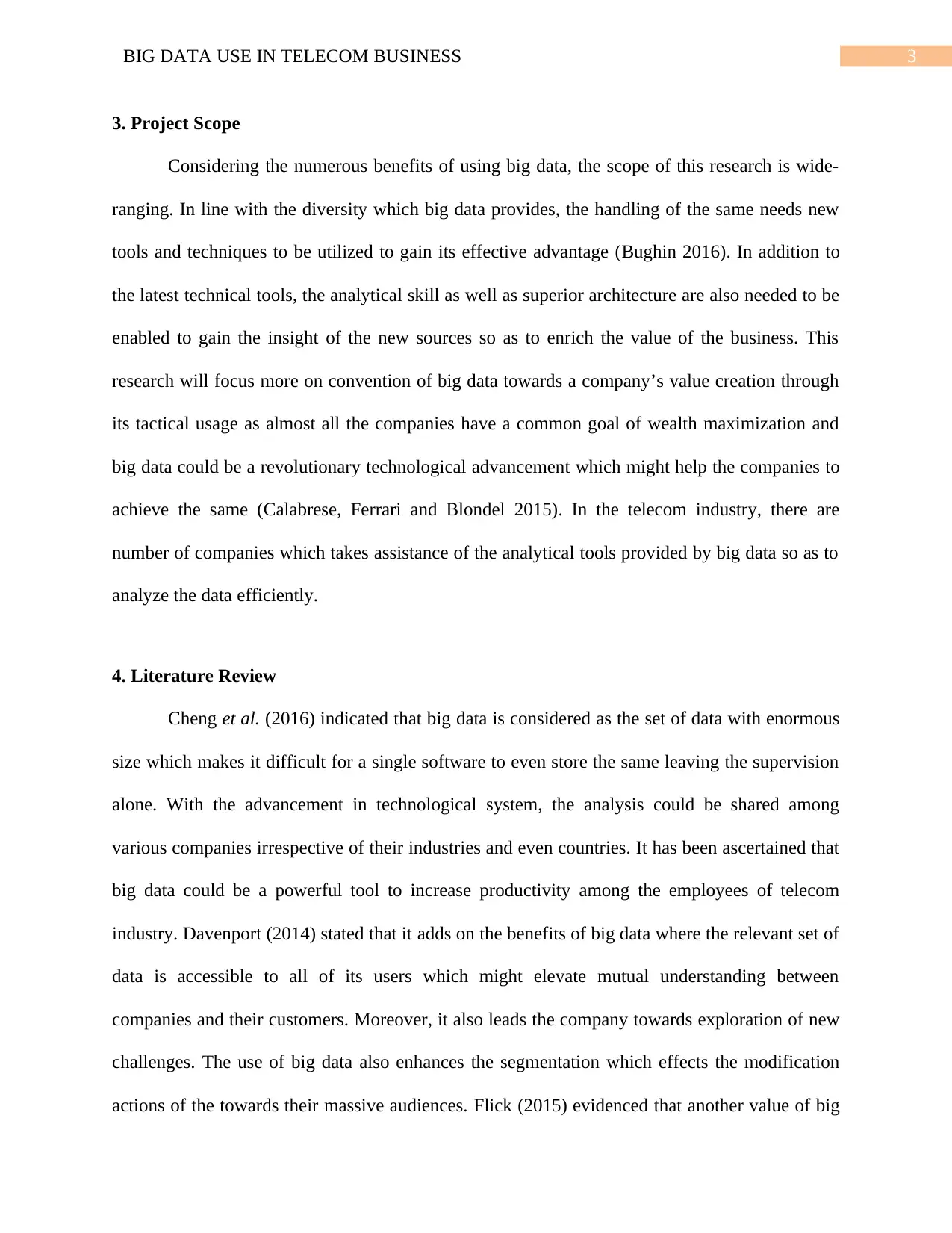
3BIG DATA USE IN TELECOM BUSINESS
3. Project Scope
Considering the numerous benefits of using big data, the scope of this research is wide-
ranging. In line with the diversity which big data provides, the handling of the same needs new
tools and techniques to be utilized to gain its effective advantage (Bughin 2016). In addition to
the latest technical tools, the analytical skill as well as superior architecture are also needed to be
enabled to gain the insight of the new sources so as to enrich the value of the business. This
research will focus more on convention of big data towards a company’s value creation through
its tactical usage as almost all the companies have a common goal of wealth maximization and
big data could be a revolutionary technological advancement which might help the companies to
achieve the same (Calabrese, Ferrari and Blondel 2015). In the telecom industry, there are
number of companies which takes assistance of the analytical tools provided by big data so as to
analyze the data efficiently.
4. Literature Review
Cheng et al. (2016) indicated that big data is considered as the set of data with enormous
size which makes it difficult for a single software to even store the same leaving the supervision
alone. With the advancement in technological system, the analysis could be shared among
various companies irrespective of their industries and even countries. It has been ascertained that
big data could be a powerful tool to increase productivity among the employees of telecom
industry. Davenport (2014) stated that it adds on the benefits of big data where the relevant set of
data is accessible to all of its users which might elevate mutual understanding between
companies and their customers. Moreover, it also leads the company towards exploration of new
challenges. The use of big data also enhances the segmentation which effects the modification
actions of the towards their massive audiences. Flick (2015) evidenced that another value of big
3. Project Scope
Considering the numerous benefits of using big data, the scope of this research is wide-
ranging. In line with the diversity which big data provides, the handling of the same needs new
tools and techniques to be utilized to gain its effective advantage (Bughin 2016). In addition to
the latest technical tools, the analytical skill as well as superior architecture are also needed to be
enabled to gain the insight of the new sources so as to enrich the value of the business. This
research will focus more on convention of big data towards a company’s value creation through
its tactical usage as almost all the companies have a common goal of wealth maximization and
big data could be a revolutionary technological advancement which might help the companies to
achieve the same (Calabrese, Ferrari and Blondel 2015). In the telecom industry, there are
number of companies which takes assistance of the analytical tools provided by big data so as to
analyze the data efficiently.
4. Literature Review
Cheng et al. (2016) indicated that big data is considered as the set of data with enormous
size which makes it difficult for a single software to even store the same leaving the supervision
alone. With the advancement in technological system, the analysis could be shared among
various companies irrespective of their industries and even countries. It has been ascertained that
big data could be a powerful tool to increase productivity among the employees of telecom
industry. Davenport (2014) stated that it adds on the benefits of big data where the relevant set of
data is accessible to all of its users which might elevate mutual understanding between
companies and their customers. Moreover, it also leads the company towards exploration of new
challenges. The use of big data also enhances the segmentation which effects the modification
actions of the towards their massive audiences. Flick (2015) evidenced that another value of big
Paraphrase This Document
Need a fresh take? Get an instant paraphrase of this document with our AI Paraphraser
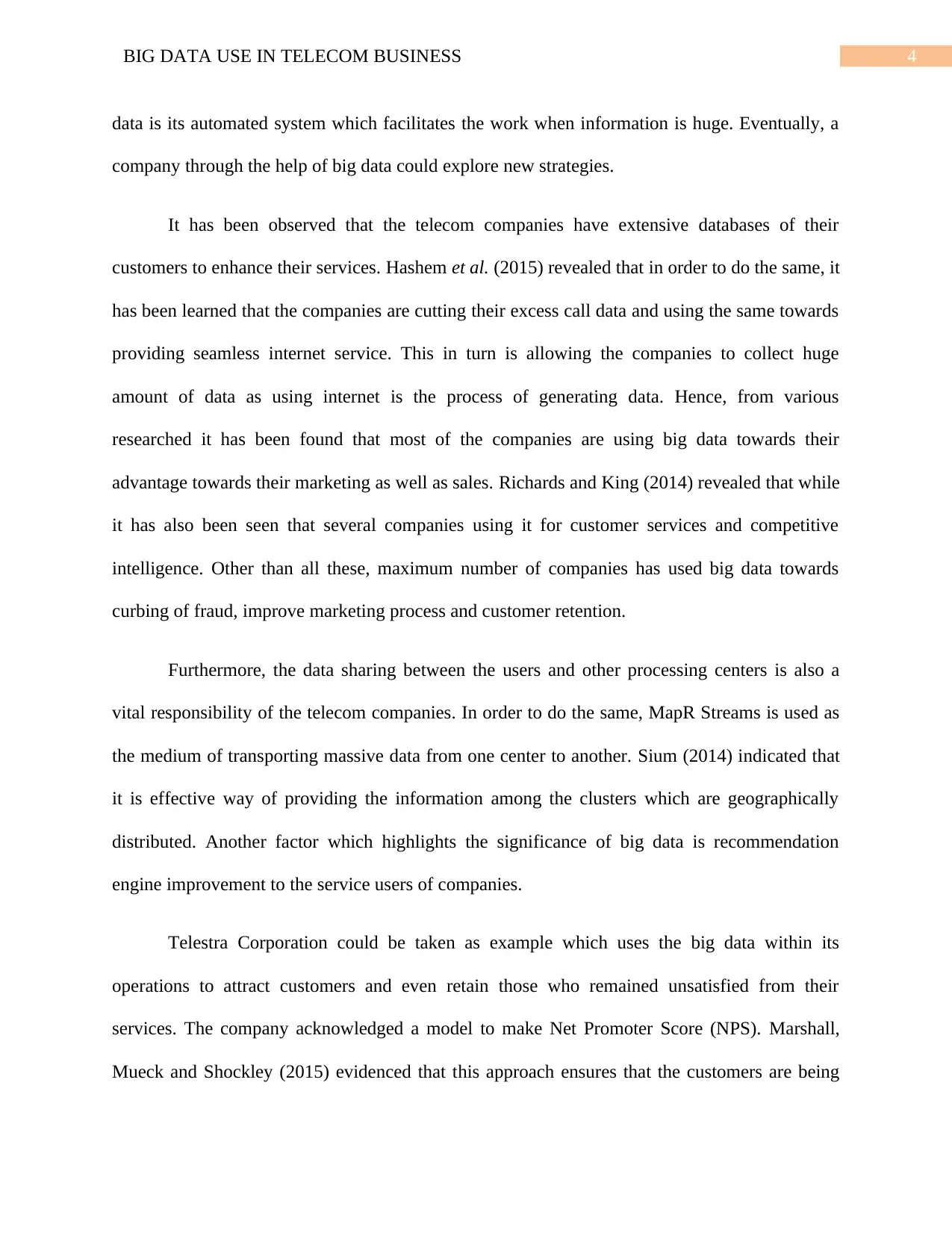
4BIG DATA USE IN TELECOM BUSINESS
data is its automated system which facilitates the work when information is huge. Eventually, a
company through the help of big data could explore new strategies.
It has been observed that the telecom companies have extensive databases of their
customers to enhance their services. Hashem et al. (2015) revealed that in order to do the same, it
has been learned that the companies are cutting their excess call data and using the same towards
providing seamless internet service. This in turn is allowing the companies to collect huge
amount of data as using internet is the process of generating data. Hence, from various
researched it has been found that most of the companies are using big data towards their
advantage towards their marketing as well as sales. Richards and King (2014) revealed that while
it has also been seen that several companies using it for customer services and competitive
intelligence. Other than all these, maximum number of companies has used big data towards
curbing of fraud, improve marketing process and customer retention.
Furthermore, the data sharing between the users and other processing centers is also a
vital responsibility of the telecom companies. In order to do the same, MapR Streams is used as
the medium of transporting massive data from one center to another. Sium (2014) indicated that
it is effective way of providing the information among the clusters which are geographically
distributed. Another factor which highlights the significance of big data is recommendation
engine improvement to the service users of companies.
Telestra Corporation could be taken as example which uses the big data within its
operations to attract customers and even retain those who remained unsatisfied from their
services. The company acknowledged a model to make Net Promoter Score (NPS). Marshall,
Mueck and Shockley (2015) evidenced that this approach ensures that the customers are being
data is its automated system which facilitates the work when information is huge. Eventually, a
company through the help of big data could explore new strategies.
It has been observed that the telecom companies have extensive databases of their
customers to enhance their services. Hashem et al. (2015) revealed that in order to do the same, it
has been learned that the companies are cutting their excess call data and using the same towards
providing seamless internet service. This in turn is allowing the companies to collect huge
amount of data as using internet is the process of generating data. Hence, from various
researched it has been found that most of the companies are using big data towards their
advantage towards their marketing as well as sales. Richards and King (2014) revealed that while
it has also been seen that several companies using it for customer services and competitive
intelligence. Other than all these, maximum number of companies has used big data towards
curbing of fraud, improve marketing process and customer retention.
Furthermore, the data sharing between the users and other processing centers is also a
vital responsibility of the telecom companies. In order to do the same, MapR Streams is used as
the medium of transporting massive data from one center to another. Sium (2014) indicated that
it is effective way of providing the information among the clusters which are geographically
distributed. Another factor which highlights the significance of big data is recommendation
engine improvement to the service users of companies.
Telestra Corporation could be taken as example which uses the big data within its
operations to attract customers and even retain those who remained unsatisfied from their
services. The company acknowledged a model to make Net Promoter Score (NPS). Marshall,
Mueck and Shockley (2015) evidenced that this approach ensures that the customers are being
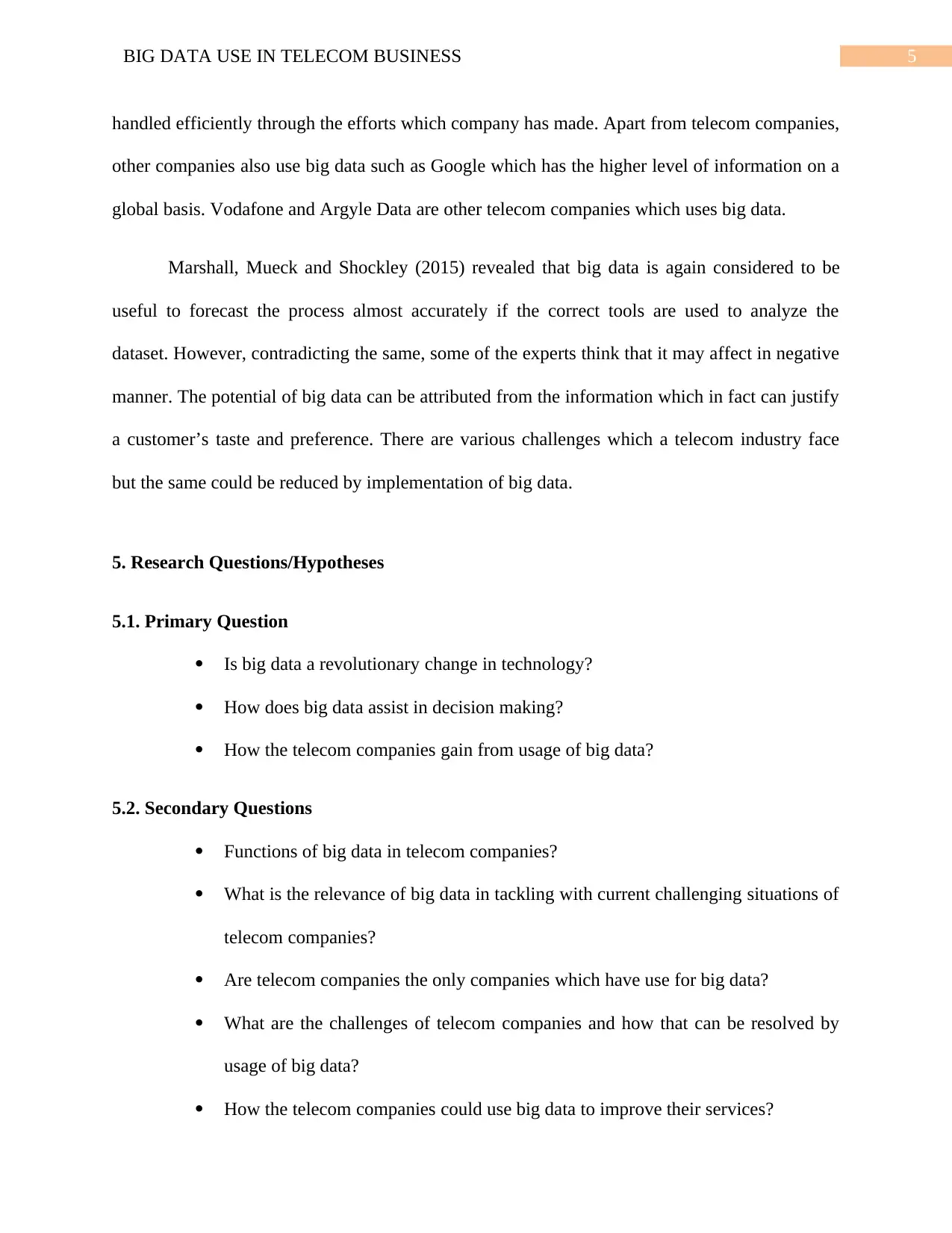
5BIG DATA USE IN TELECOM BUSINESS
handled efficiently through the efforts which company has made. Apart from telecom companies,
other companies also use big data such as Google which has the higher level of information on a
global basis. Vodafone and Argyle Data are other telecom companies which uses big data.
Marshall, Mueck and Shockley (2015) revealed that big data is again considered to be
useful to forecast the process almost accurately if the correct tools are used to analyze the
dataset. However, contradicting the same, some of the experts think that it may affect in negative
manner. The potential of big data can be attributed from the information which in fact can justify
a customer’s taste and preference. There are various challenges which a telecom industry face
but the same could be reduced by implementation of big data.
5. Research Questions/Hypotheses
5.1. Primary Question
Is big data a revolutionary change in technology?
How does big data assist in decision making?
How the telecom companies gain from usage of big data?
5.2. Secondary Questions
Functions of big data in telecom companies?
What is the relevance of big data in tackling with current challenging situations of
telecom companies?
Are telecom companies the only companies which have use for big data?
What are the challenges of telecom companies and how that can be resolved by
usage of big data?
How the telecom companies could use big data to improve their services?
handled efficiently through the efforts which company has made. Apart from telecom companies,
other companies also use big data such as Google which has the higher level of information on a
global basis. Vodafone and Argyle Data are other telecom companies which uses big data.
Marshall, Mueck and Shockley (2015) revealed that big data is again considered to be
useful to forecast the process almost accurately if the correct tools are used to analyze the
dataset. However, contradicting the same, some of the experts think that it may affect in negative
manner. The potential of big data can be attributed from the information which in fact can justify
a customer’s taste and preference. There are various challenges which a telecom industry face
but the same could be reduced by implementation of big data.
5. Research Questions/Hypotheses
5.1. Primary Question
Is big data a revolutionary change in technology?
How does big data assist in decision making?
How the telecom companies gain from usage of big data?
5.2. Secondary Questions
Functions of big data in telecom companies?
What is the relevance of big data in tackling with current challenging situations of
telecom companies?
Are telecom companies the only companies which have use for big data?
What are the challenges of telecom companies and how that can be resolved by
usage of big data?
How the telecom companies could use big data to improve their services?
⊘ This is a preview!⊘
Do you want full access?
Subscribe today to unlock all pages.

Trusted by 1+ million students worldwide
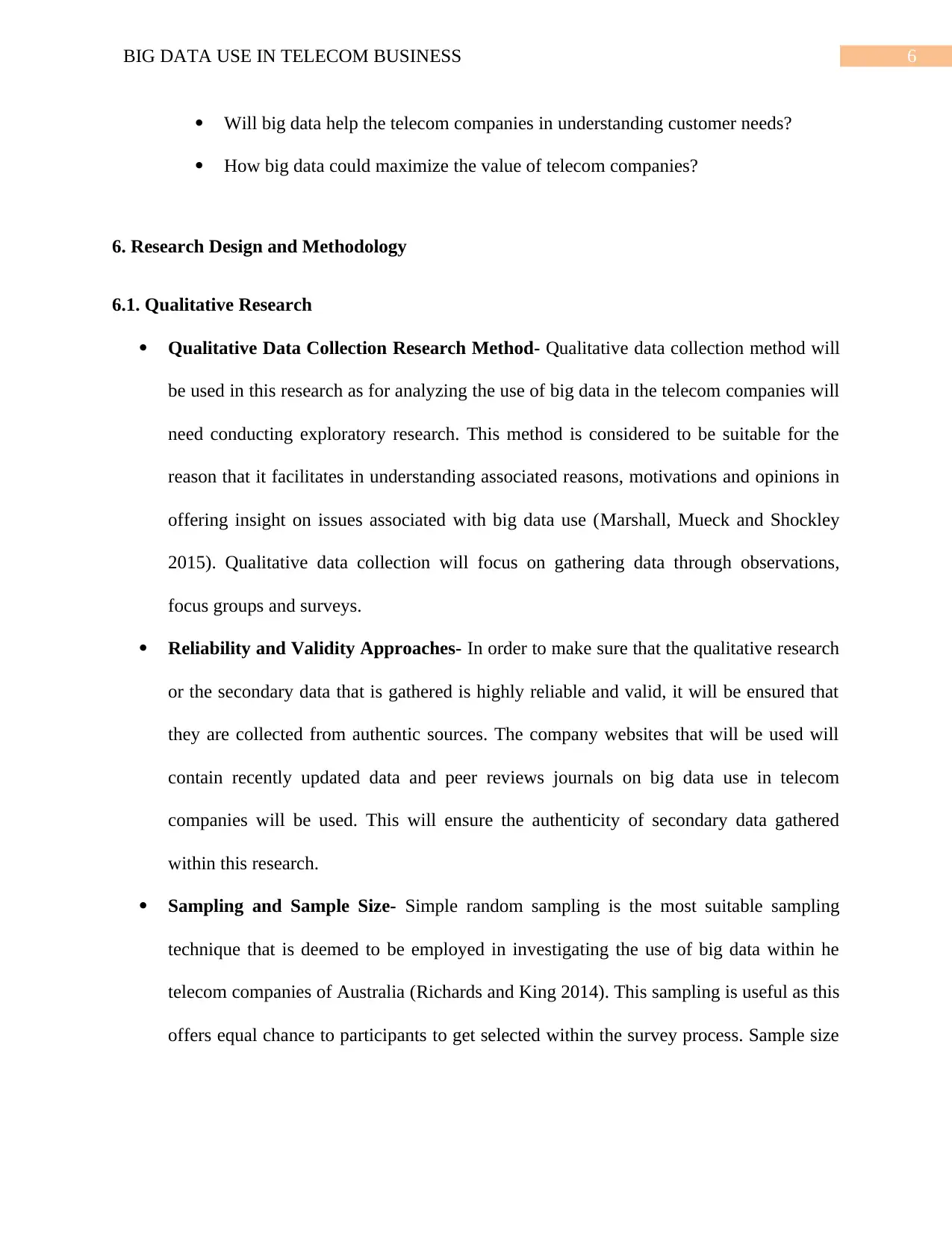
6BIG DATA USE IN TELECOM BUSINESS
Will big data help the telecom companies in understanding customer needs?
How big data could maximize the value of telecom companies?
6. Research Design and Methodology
6.1. Qualitative Research
Qualitative Data Collection Research Method- Qualitative data collection method will
be used in this research as for analyzing the use of big data in the telecom companies will
need conducting exploratory research. This method is considered to be suitable for the
reason that it facilitates in understanding associated reasons, motivations and opinions in
offering insight on issues associated with big data use (Marshall, Mueck and Shockley
2015). Qualitative data collection will focus on gathering data through observations,
focus groups and surveys.
Reliability and Validity Approaches- In order to make sure that the qualitative research
or the secondary data that is gathered is highly reliable and valid, it will be ensured that
they are collected from authentic sources. The company websites that will be used will
contain recently updated data and peer reviews journals on big data use in telecom
companies will be used. This will ensure the authenticity of secondary data gathered
within this research.
Sampling and Sample Size- Simple random sampling is the most suitable sampling
technique that is deemed to be employed in investigating the use of big data within he
telecom companies of Australia (Richards and King 2014). This sampling is useful as this
offers equal chance to participants to get selected within the survey process. Sample size
Will big data help the telecom companies in understanding customer needs?
How big data could maximize the value of telecom companies?
6. Research Design and Methodology
6.1. Qualitative Research
Qualitative Data Collection Research Method- Qualitative data collection method will
be used in this research as for analyzing the use of big data in the telecom companies will
need conducting exploratory research. This method is considered to be suitable for the
reason that it facilitates in understanding associated reasons, motivations and opinions in
offering insight on issues associated with big data use (Marshall, Mueck and Shockley
2015). Qualitative data collection will focus on gathering data through observations,
focus groups and surveys.
Reliability and Validity Approaches- In order to make sure that the qualitative research
or the secondary data that is gathered is highly reliable and valid, it will be ensured that
they are collected from authentic sources. The company websites that will be used will
contain recently updated data and peer reviews journals on big data use in telecom
companies will be used. This will ensure the authenticity of secondary data gathered
within this research.
Sampling and Sample Size- Simple random sampling is the most suitable sampling
technique that is deemed to be employed in investigating the use of big data within he
telecom companies of Australia (Richards and King 2014). This sampling is useful as this
offers equal chance to participants to get selected within the survey process. Sample size
Paraphrase This Document
Need a fresh take? Get an instant paraphrase of this document with our AI Paraphraser
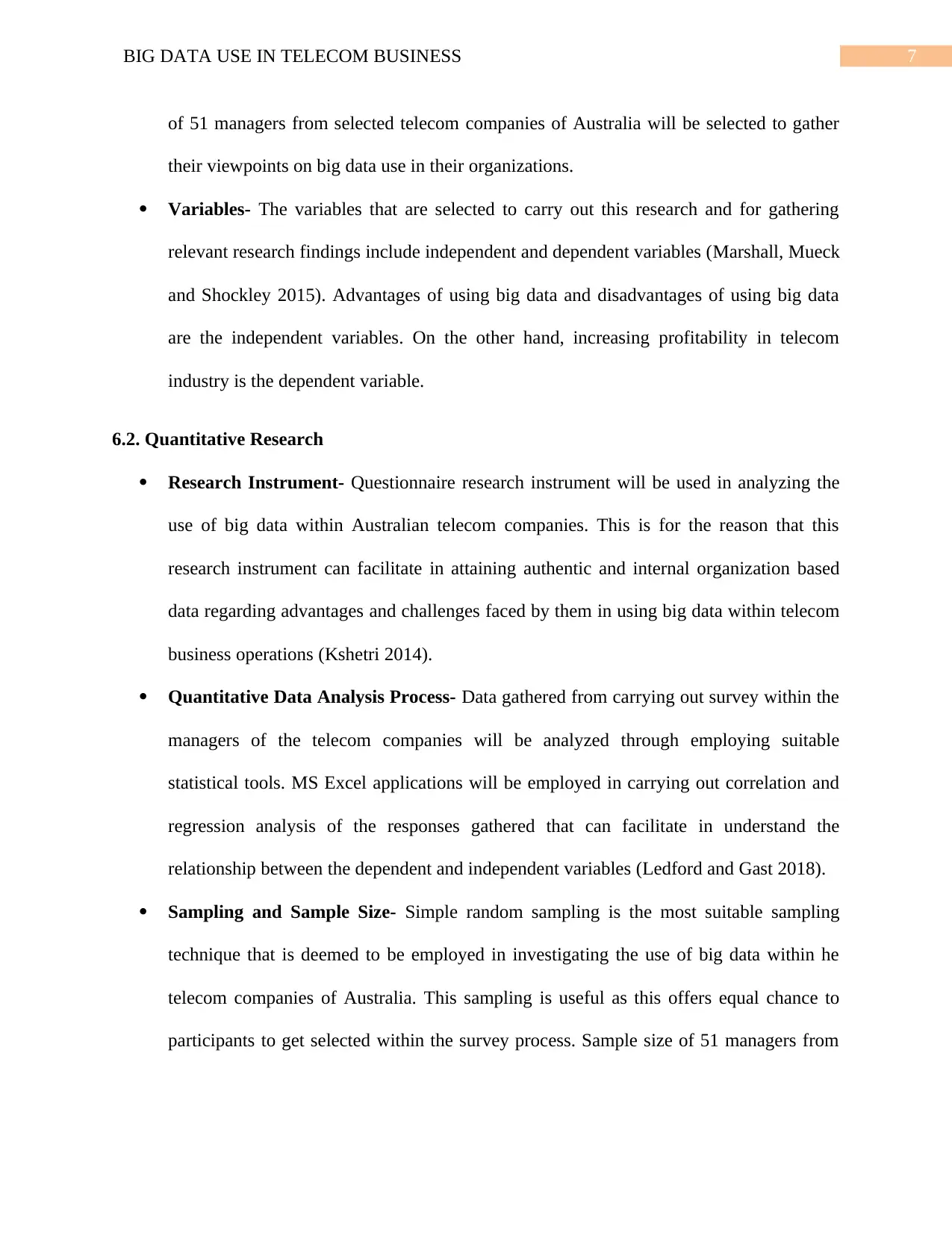
7BIG DATA USE IN TELECOM BUSINESS
of 51 managers from selected telecom companies of Australia will be selected to gather
their viewpoints on big data use in their organizations.
Variables- The variables that are selected to carry out this research and for gathering
relevant research findings include independent and dependent variables (Marshall, Mueck
and Shockley 2015). Advantages of using big data and disadvantages of using big data
are the independent variables. On the other hand, increasing profitability in telecom
industry is the dependent variable.
6.2. Quantitative Research
Research Instrument- Questionnaire research instrument will be used in analyzing the
use of big data within Australian telecom companies. This is for the reason that this
research instrument can facilitate in attaining authentic and internal organization based
data regarding advantages and challenges faced by them in using big data within telecom
business operations (Kshetri 2014).
Quantitative Data Analysis Process- Data gathered from carrying out survey within the
managers of the telecom companies will be analyzed through employing suitable
statistical tools. MS Excel applications will be employed in carrying out correlation and
regression analysis of the responses gathered that can facilitate in understand the
relationship between the dependent and independent variables (Ledford and Gast 2018).
Sampling and Sample Size- Simple random sampling is the most suitable sampling
technique that is deemed to be employed in investigating the use of big data within he
telecom companies of Australia. This sampling is useful as this offers equal chance to
participants to get selected within the survey process. Sample size of 51 managers from
of 51 managers from selected telecom companies of Australia will be selected to gather
their viewpoints on big data use in their organizations.
Variables- The variables that are selected to carry out this research and for gathering
relevant research findings include independent and dependent variables (Marshall, Mueck
and Shockley 2015). Advantages of using big data and disadvantages of using big data
are the independent variables. On the other hand, increasing profitability in telecom
industry is the dependent variable.
6.2. Quantitative Research
Research Instrument- Questionnaire research instrument will be used in analyzing the
use of big data within Australian telecom companies. This is for the reason that this
research instrument can facilitate in attaining authentic and internal organization based
data regarding advantages and challenges faced by them in using big data within telecom
business operations (Kshetri 2014).
Quantitative Data Analysis Process- Data gathered from carrying out survey within the
managers of the telecom companies will be analyzed through employing suitable
statistical tools. MS Excel applications will be employed in carrying out correlation and
regression analysis of the responses gathered that can facilitate in understand the
relationship between the dependent and independent variables (Ledford and Gast 2018).
Sampling and Sample Size- Simple random sampling is the most suitable sampling
technique that is deemed to be employed in investigating the use of big data within he
telecom companies of Australia. This sampling is useful as this offers equal chance to
participants to get selected within the survey process. Sample size of 51 managers from
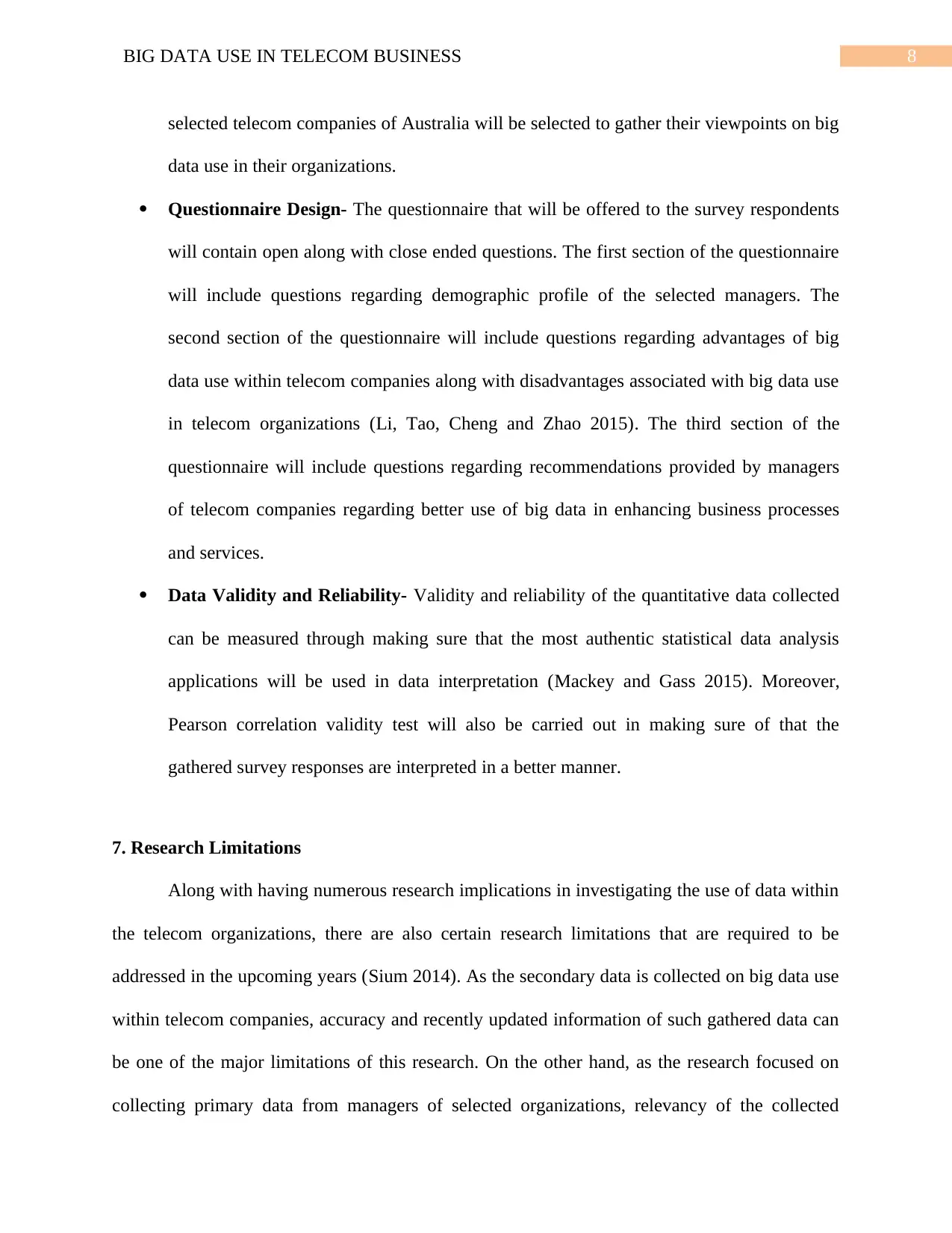
8BIG DATA USE IN TELECOM BUSINESS
selected telecom companies of Australia will be selected to gather their viewpoints on big
data use in their organizations.
Questionnaire Design- The questionnaire that will be offered to the survey respondents
will contain open along with close ended questions. The first section of the questionnaire
will include questions regarding demographic profile of the selected managers. The
second section of the questionnaire will include questions regarding advantages of big
data use within telecom companies along with disadvantages associated with big data use
in telecom organizations (Li, Tao, Cheng and Zhao 2015). The third section of the
questionnaire will include questions regarding recommendations provided by managers
of telecom companies regarding better use of big data in enhancing business processes
and services.
Data Validity and Reliability- Validity and reliability of the quantitative data collected
can be measured through making sure that the most authentic statistical data analysis
applications will be used in data interpretation (Mackey and Gass 2015). Moreover,
Pearson correlation validity test will also be carried out in making sure of that the
gathered survey responses are interpreted in a better manner.
7. Research Limitations
Along with having numerous research implications in investigating the use of data within
the telecom organizations, there are also certain research limitations that are required to be
addressed in the upcoming years (Sium 2014). As the secondary data is collected on big data use
within telecom companies, accuracy and recently updated information of such gathered data can
be one of the major limitations of this research. On the other hand, as the research focused on
collecting primary data from managers of selected organizations, relevancy of the collected
selected telecom companies of Australia will be selected to gather their viewpoints on big
data use in their organizations.
Questionnaire Design- The questionnaire that will be offered to the survey respondents
will contain open along with close ended questions. The first section of the questionnaire
will include questions regarding demographic profile of the selected managers. The
second section of the questionnaire will include questions regarding advantages of big
data use within telecom companies along with disadvantages associated with big data use
in telecom organizations (Li, Tao, Cheng and Zhao 2015). The third section of the
questionnaire will include questions regarding recommendations provided by managers
of telecom companies regarding better use of big data in enhancing business processes
and services.
Data Validity and Reliability- Validity and reliability of the quantitative data collected
can be measured through making sure that the most authentic statistical data analysis
applications will be used in data interpretation (Mackey and Gass 2015). Moreover,
Pearson correlation validity test will also be carried out in making sure of that the
gathered survey responses are interpreted in a better manner.
7. Research Limitations
Along with having numerous research implications in investigating the use of data within
the telecom organizations, there are also certain research limitations that are required to be
addressed in the upcoming years (Sium 2014). As the secondary data is collected on big data use
within telecom companies, accuracy and recently updated information of such gathered data can
be one of the major limitations of this research. On the other hand, as the research focused on
collecting primary data from managers of selected organizations, relevancy of the collected
⊘ This is a preview!⊘
Do you want full access?
Subscribe today to unlock all pages.

Trusted by 1+ million students worldwide
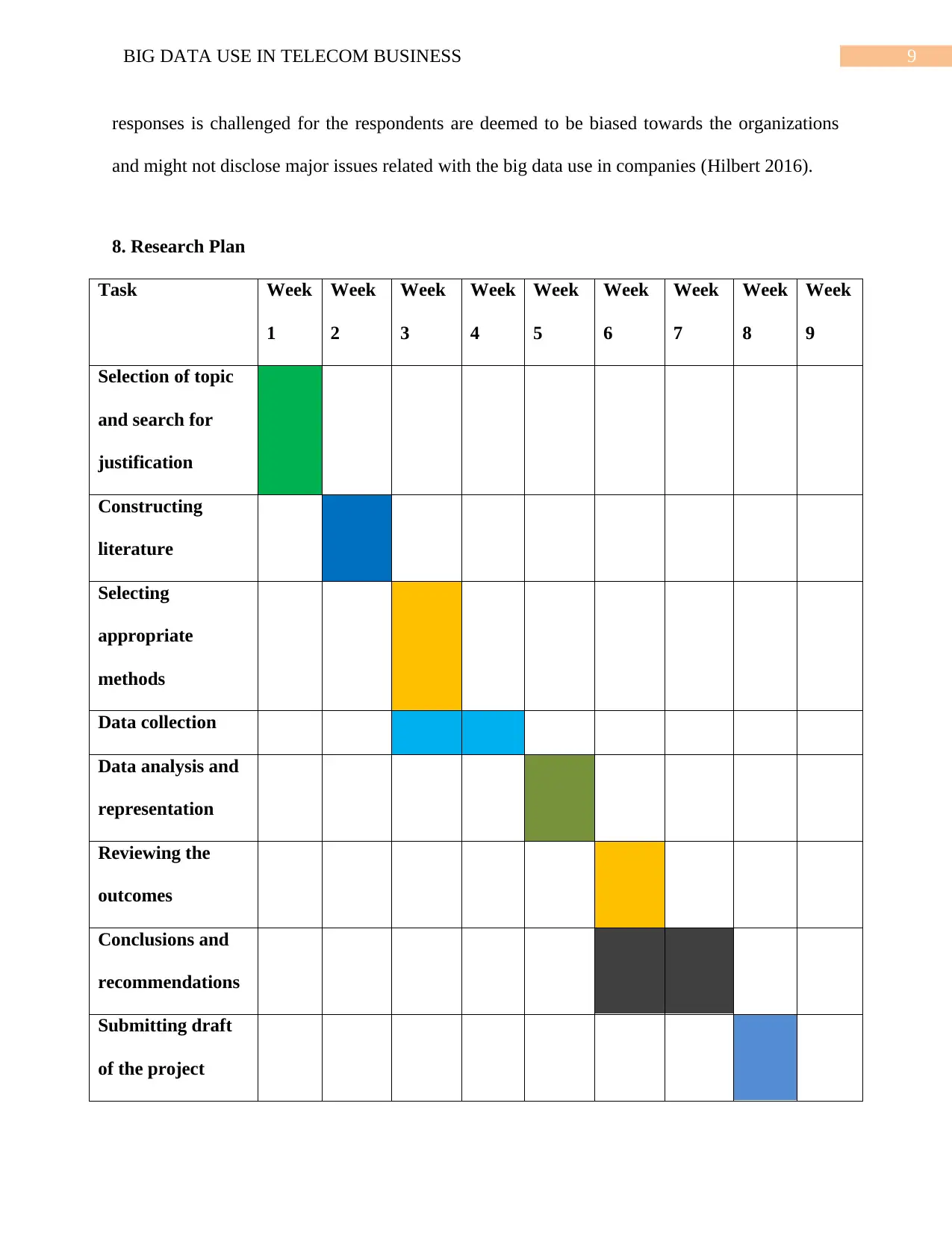
9BIG DATA USE IN TELECOM BUSINESS
responses is challenged for the respondents are deemed to be biased towards the organizations
and might not disclose major issues related with the big data use in companies (Hilbert 2016).
8. Research Plan
Task Week
1
Week
2
Week
3
Week
4
Week
5
Week
6
Week
7
Week
8
Week
9
Selection of topic
and search for
justification
Constructing
literature
Selecting
appropriate
methods
Data collection
Data analysis and
representation
Reviewing the
outcomes
Conclusions and
recommendations
Submitting draft
of the project
responses is challenged for the respondents are deemed to be biased towards the organizations
and might not disclose major issues related with the big data use in companies (Hilbert 2016).
8. Research Plan
Task Week
1
Week
2
Week
3
Week
4
Week
5
Week
6
Week
7
Week
8
Week
9
Selection of topic
and search for
justification
Constructing
literature
Selecting
appropriate
methods
Data collection
Data analysis and
representation
Reviewing the
outcomes
Conclusions and
recommendations
Submitting draft
of the project
Paraphrase This Document
Need a fresh take? Get an instant paraphrase of this document with our AI Paraphraser
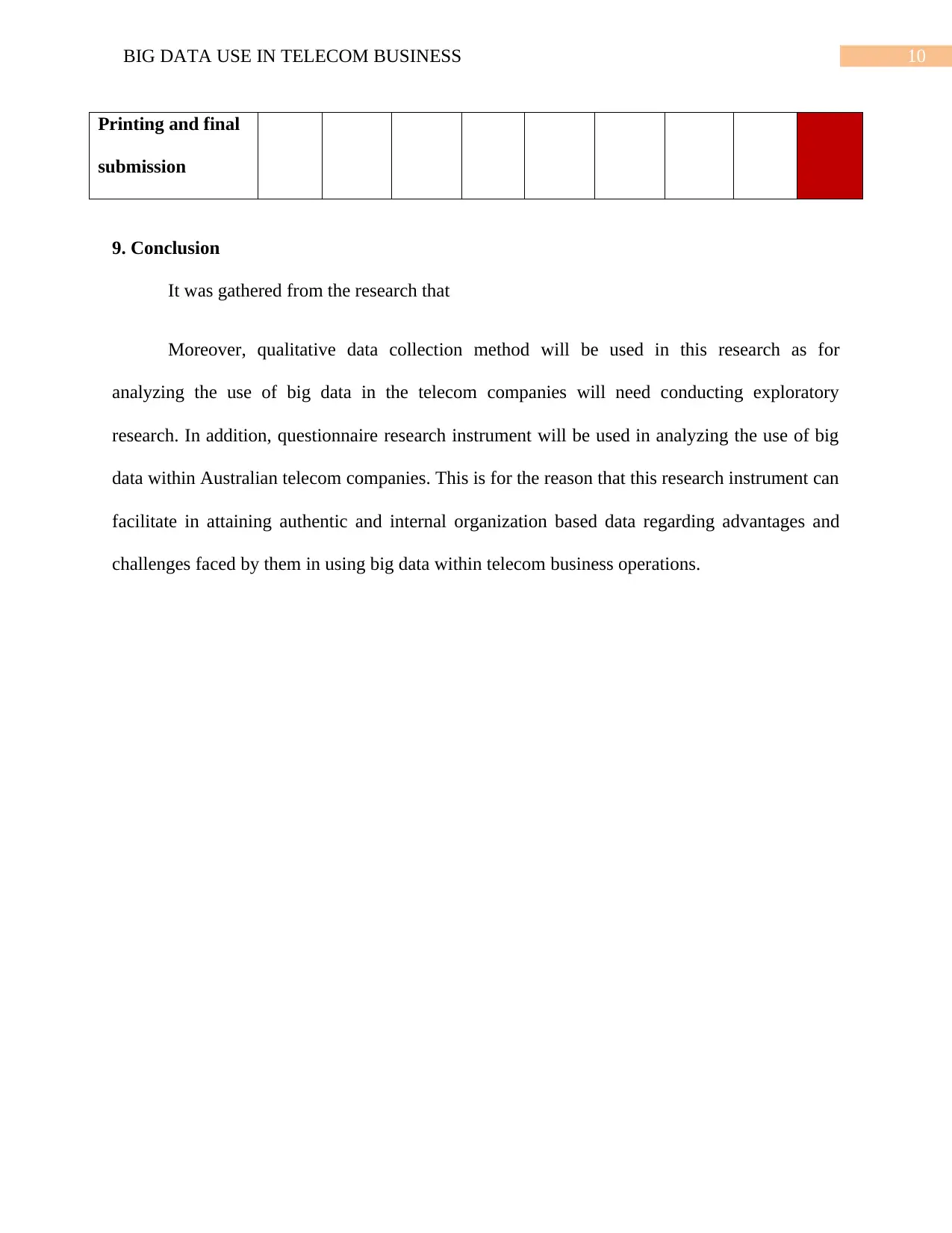
10BIG DATA USE IN TELECOM BUSINESS
Printing and final
submission
9. Conclusion
It was gathered from the research that
Moreover, qualitative data collection method will be used in this research as for
analyzing the use of big data in the telecom companies will need conducting exploratory
research. In addition, questionnaire research instrument will be used in analyzing the use of big
data within Australian telecom companies. This is for the reason that this research instrument can
facilitate in attaining authentic and internal organization based data regarding advantages and
challenges faced by them in using big data within telecom business operations.
Printing and final
submission
9. Conclusion
It was gathered from the research that
Moreover, qualitative data collection method will be used in this research as for
analyzing the use of big data in the telecom companies will need conducting exploratory
research. In addition, questionnaire research instrument will be used in analyzing the use of big
data within Australian telecom companies. This is for the reason that this research instrument can
facilitate in attaining authentic and internal organization based data regarding advantages and
challenges faced by them in using big data within telecom business operations.
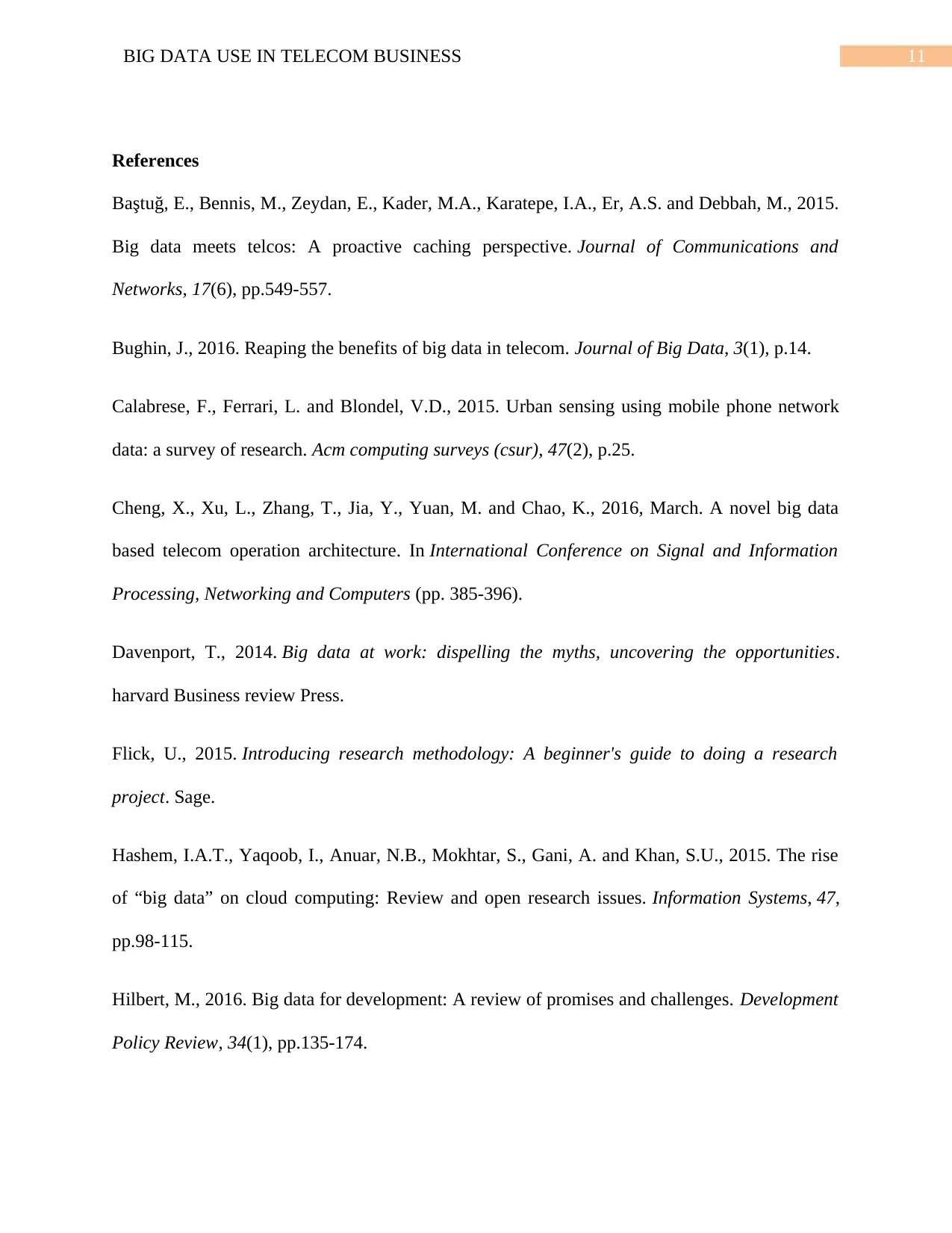
11BIG DATA USE IN TELECOM BUSINESS
References
Baştuğ, E., Bennis, M., Zeydan, E., Kader, M.A., Karatepe, I.A., Er, A.S. and Debbah, M., 2015.
Big data meets telcos: A proactive caching perspective. Journal of Communications and
Networks, 17(6), pp.549-557.
Bughin, J., 2016. Reaping the benefits of big data in telecom. Journal of Big Data, 3(1), p.14.
Calabrese, F., Ferrari, L. and Blondel, V.D., 2015. Urban sensing using mobile phone network
data: a survey of research. Acm computing surveys (csur), 47(2), p.25.
Cheng, X., Xu, L., Zhang, T., Jia, Y., Yuan, M. and Chao, K., 2016, March. A novel big data
based telecom operation architecture. In International Conference on Signal and Information
Processing, Networking and Computers (pp. 385-396).
Davenport, T., 2014. Big data at work: dispelling the myths, uncovering the opportunities.
harvard Business review Press.
Flick, U., 2015. Introducing research methodology: A beginner's guide to doing a research
project. Sage.
Hashem, I.A.T., Yaqoob, I., Anuar, N.B., Mokhtar, S., Gani, A. and Khan, S.U., 2015. The rise
of “big data” on cloud computing: Review and open research issues. Information Systems, 47,
pp.98-115.
Hilbert, M., 2016. Big data for development: A review of promises and challenges. Development
Policy Review, 34(1), pp.135-174.
References
Baştuğ, E., Bennis, M., Zeydan, E., Kader, M.A., Karatepe, I.A., Er, A.S. and Debbah, M., 2015.
Big data meets telcos: A proactive caching perspective. Journal of Communications and
Networks, 17(6), pp.549-557.
Bughin, J., 2016. Reaping the benefits of big data in telecom. Journal of Big Data, 3(1), p.14.
Calabrese, F., Ferrari, L. and Blondel, V.D., 2015. Urban sensing using mobile phone network
data: a survey of research. Acm computing surveys (csur), 47(2), p.25.
Cheng, X., Xu, L., Zhang, T., Jia, Y., Yuan, M. and Chao, K., 2016, March. A novel big data
based telecom operation architecture. In International Conference on Signal and Information
Processing, Networking and Computers (pp. 385-396).
Davenport, T., 2014. Big data at work: dispelling the myths, uncovering the opportunities.
harvard Business review Press.
Flick, U., 2015. Introducing research methodology: A beginner's guide to doing a research
project. Sage.
Hashem, I.A.T., Yaqoob, I., Anuar, N.B., Mokhtar, S., Gani, A. and Khan, S.U., 2015. The rise
of “big data” on cloud computing: Review and open research issues. Information Systems, 47,
pp.98-115.
Hilbert, M., 2016. Big data for development: A review of promises and challenges. Development
Policy Review, 34(1), pp.135-174.
⊘ This is a preview!⊘
Do you want full access?
Subscribe today to unlock all pages.

Trusted by 1+ million students worldwide
1 out of 13
Related Documents
Your All-in-One AI-Powered Toolkit for Academic Success.
+13062052269
info@desklib.com
Available 24*7 on WhatsApp / Email
![[object Object]](/_next/static/media/star-bottom.7253800d.svg)
Unlock your academic potential
Copyright © 2020–2025 A2Z Services. All Rights Reserved. Developed and managed by ZUCOL.




